
IEI Technology NANO-HM651 Manuals
Manuals and User Guides for IEI Technology NANO-HM651. We have 1 IEI Technology NANO-HM651 manual available for free PDF download: User Manual
IEI Technology NANO-HM651 User Manual (165 pages)
EPIC SBC with Intel Celeron 847E Dual-Core CPU and Intel HM65 Chipset, DDR3, VGA, HDMI, USB 3.0, Dual PCle GbE, SATA 6Gb/s, HD Audio, RoHS Compliant
Brand: IEI Technology
|
Category: Motherboard
|
Size: 9 MB
Table of Contents
Advertisement
